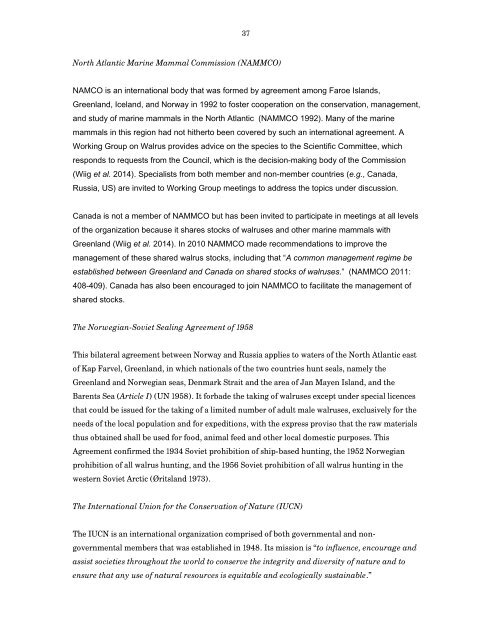The State of Circumpolar Walrus Populations
walrusreport
walrusreport
Create successful ePaper yourself
Turn your PDF publications into a flip-book with our unique Google optimized e-Paper software.
37<br />
North Atlantic Marine Mammal Commission (NAMMCO)<br />
NAMCO is an international body that was formed by agreement among Faroe Islands,<br />
Greenland, Iceland, and Norway in 1992 to foster cooperation on the conservation, management,<br />
and study <strong>of</strong> marine mammals in the North Atlantic (NAMMCO 1992). Many <strong>of</strong> the marine<br />
mammals in this region had not hitherto been covered by such an international agreement. A<br />
Working Group on <strong>Walrus</strong> provides advice on the species to the Scientific Committee, which<br />
responds to requests from the Council, which is the decision-making body <strong>of</strong> the Commission<br />
(Wiig et al. 2014). Specialists from both member and non-member countries (e.g., Canada,<br />
Russia, US) are invited to Working Group meetings to address the topics under discussion.<br />
Canada is not a member <strong>of</strong> NAMMCO but has been invited to participate in meetings at all levels<br />
<strong>of</strong> the organization because it shares stocks <strong>of</strong> walruses and other marine mammals with<br />
Greenland (Wiig et al. 2014). In 2010 NAMMCO made recommendations to improve the<br />
management <strong>of</strong> these shared walrus stocks, including that “A common management regime be<br />
established between Greenland and Canada on shared stocks <strong>of</strong> walruses.” (NAMMCO 2011:<br />
408-409). Canada has also been encouraged to join NAMMCO to facilitate the management <strong>of</strong><br />
shared stocks.<br />
<strong>The</strong> Norwegian-Soviet Sealing Agreement <strong>of</strong> 1958<br />
This bilateral agreement between Norway and Russia applies to waters <strong>of</strong> the North Atlantic east<br />
<strong>of</strong> Kap Farvel, Greenland, in which nationals <strong>of</strong> the two countries hunt seals, namely the<br />
Greenland and Norwegian seas, Denmark Strait and the area <strong>of</strong> Jan Mayen Island, and the<br />
Barents Sea (Article I) (UN 1958). It forbade the taking <strong>of</strong> walruses except under special licences<br />
that could be issued for the taking <strong>of</strong> a limited number <strong>of</strong> adult male walruses, exclusively for the<br />
needs <strong>of</strong> the local population and for expeditions, with the express proviso that the raw materials<br />
thus obtained shall be used for food, animal feed and other local domestic purposes. This<br />
Agreement confirmed the 1934 Soviet prohibition <strong>of</strong> ship-based hunting, the 1952 Norwegian<br />
prohibition <strong>of</strong> all walrus hunting, and the 1956 Soviet prohibition <strong>of</strong> all walrus hunting in the<br />
western Soviet Arctic (Øritsland 1973).<br />
<strong>The</strong> International Union for the Conservation <strong>of</strong> Nature (IUCN)<br />
<strong>The</strong> IUCN is an international organization comprised <strong>of</strong> both governmental and nongovernmental<br />
members that was established in 1948. Its mission is “to influence, encourage and<br />
assist societies throughout the world to conserve the integrity and diversity <strong>of</strong> nature and to<br />
ensure that any use <strong>of</strong> natural resources is equitable and ecologically sustainable.”


